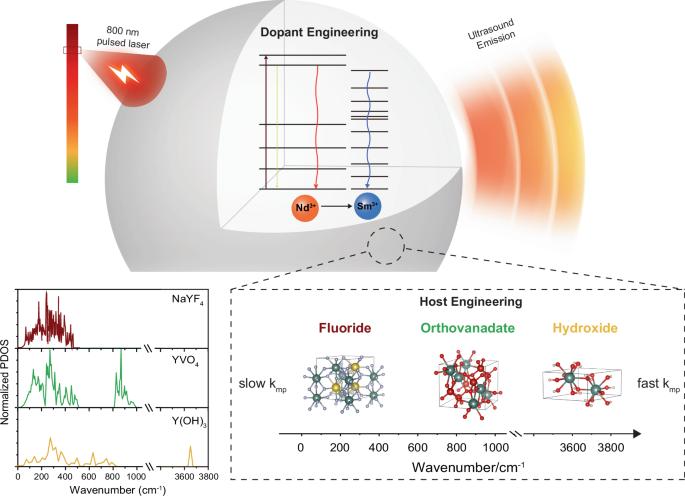Sharp-peaked lanthanide nanocrystals for near-infrared photoacoustic multiplexed differential imaging
IF 7.5
Q1 MATERIALS SCIENCE, MULTIDISCIPLINARY
引用次数: 0
Abstract
Photoacoustic tomography offers a powerful tool to visualize biologically relevant molecules and understand processes within living systems at high resolution in deep tissue, facilitated by the conversion of incident photons into low-scattering acoustic waves through non-radiative relaxation. Although current endogenous and exogenous photoacoustic contrast agents effectively enable molecular imaging within deep tissues, their broad absorption spectra in the visible to near-infrared (NIR) range limit photoacoustic multiplexed imaging. Here, we exploit the distinct ultrasharp NIR absorption peaks of lanthanides to engineer a series of NIR photoacoustic nanocrystals. This engineering involves precise host and dopant material composition, yielding nanocrystals with sharply peaked photoacoustic absorption spectra (~3.2 nm width) and a ~10-fold enhancement in NIR optical absorption for efficient deep tissue imaging. By combining photoacoustic tomography with these engineered nanocrystals, we demonstrate photoacoustic multiplexed differential imaging with substantially decreased background signals and enhanced precision and contrast. Current photoacoustic contrast agents cannot be used for multiplexed imaging due to their broad absorption spectra in the visible to near-infrared range. Here, the sharp near-infrared absorption peaks of lanthanides are exploited for photoacoustic and efficient deep tissue imaging.

用于近红外光声多路复用差分成像的尖峰镧系纳米晶体
光声断层成像技术提供了一种强大的工具,通过非辐射弛豫将入射光子转化为低散射声波,从而在深部组织中以高分辨率观察生物相关分子并了解生命系统内的过程。虽然目前的内源性和外源性光声造影剂能有效实现深部组织内的分子成像,但它们在可见光到近红外(NIR)范围内的宽吸收光谱限制了光声多重成像。在这里,我们利用镧系元素独特的超锐利近红外吸收峰,设计出一系列近红外光声纳米晶体。这一工程涉及精确的主材料和掺杂材料组成,产生的纳米晶体具有尖锐的光声吸收光谱峰值(约 3.2 nm 宽)和约 10 倍的近红外光学吸收增强,可用于高效的深部组织成像。通过将光声断层成像技术与这些工程纳米晶体相结合,我们展示了光声多路复用差分成像技术,其背景信号大大降低,精确度和对比度得到增强。由于当前的光声造影剂在可见光到近红外范围内的吸收光谱较宽,因此无法用于多路复用成像。在这里,镧系元素尖锐的近红外吸收峰被用于光声和高效的深部组织成像。
本文章由计算机程序翻译,如有差异,请以英文原文为准。
求助全文
约1分钟内获得全文
求助全文
来源期刊

Communications Materials
MATERIALS SCIENCE, MULTIDISCIPLINARY-
CiteScore
12.10
自引率
1.30%
发文量
85
审稿时长
17 weeks
期刊介绍:
Communications Materials, a selective open access journal within Nature Portfolio, is dedicated to publishing top-tier research, reviews, and commentary across all facets of materials science. The journal showcases significant advancements in specialized research areas, encompassing both fundamental and applied studies. Serving as an open access option for materials sciences, Communications Materials applies less stringent criteria for impact and significance compared to Nature-branded journals, including Nature Communications.
 求助内容:
求助内容: 应助结果提醒方式:
应助结果提醒方式:


